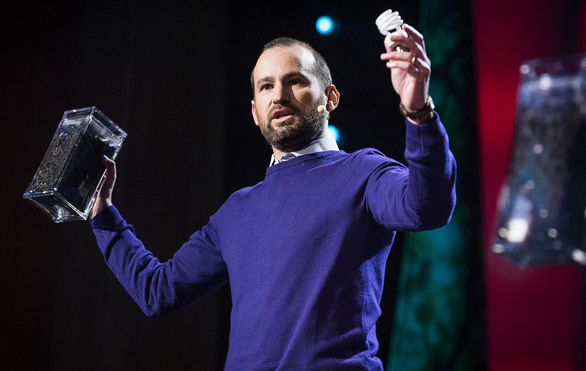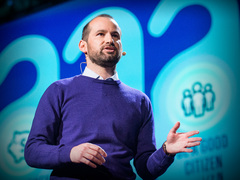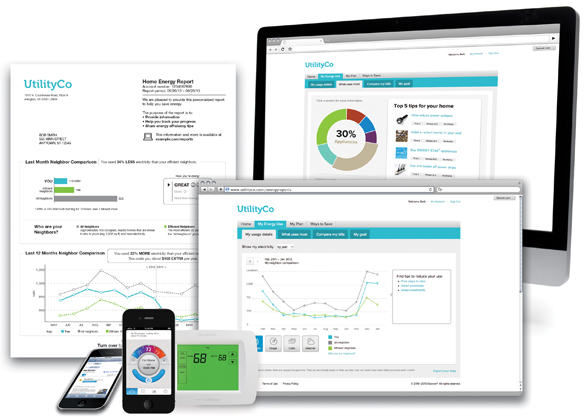
Alex Laskey of Opower shows the amount of coal that should be able to power a lightbulb for a year. But because of massive energy waste, ten timess as much coal is needed. Photo: James Duncan Davidson
“For the past five years we’ve been running the largest behavioral science experiment in the world,” says Alex Laskey in today’s TED Talk, given at this year’s 2013 conference in Long Beach. “And, it’s working.”
 Alex Laskey: How behavioral science can lower your energy bill
Laskey’s company Opower partners with utility companies to deliver personalized home energy reports, all based off the insight that people are more inclined to take action on an issue when they think other people are doing better than they are. People’s energy consumption changes for the better after receiving these reports — either in the mail or through their app and website — and the effects appear to be long-lasting. This year, Laskey says, Opower expects to inspire 2 terawatt hours (TWh) in saved electricity. That’s enough to power a city of more than a quarter million people for a year.
Alex Laskey: How behavioral science can lower your energy bill
Laskey’s company Opower partners with utility companies to deliver personalized home energy reports, all based off the insight that people are more inclined to take action on an issue when they think other people are doing better than they are. People’s energy consumption changes for the better after receiving these reports — either in the mail or through their app and website — and the effects appear to be long-lasting. This year, Laskey says, Opower expects to inspire 2 terawatt hours (TWh) in saved electricity. That’s enough to power a city of more than a quarter million people for a year.
This idea was sparked by a study run a decade ago by Arizona State University psychology professor, Robert Cialdini, who conducted an experiment to see what might make people turn off their air conditioner, and turn on their fan. Might money persuade them? Or an appeal to their better selves? Or the thought of saving the planet? Nope, nope and nope. Turns out, the one surefire way to get people to do something was to tell them their neighbors were already doing it. As Laskey comments in his talk, “Social pressure is powerful stuff.”
 Sendhil Mullainathan: Solving social problems with a nudge
That’s why Laskey and his team at Opower have partnered with behavioral scientists, including Cialdini, to experiment with different types of insights and, in doing so, try to make a dent in the giant energy problems facing the world. One of their unofficial advisers is Sendhil Mullainathan, professor of economics at Harvard and founder of Ideas42, a company “using behavioral economics to do good.” (Watch Mullainathan’s 2009 TED Talk from TED India, Solving social problems with a nudge »)
Sendhil Mullainathan: Solving social problems with a nudge
That’s why Laskey and his team at Opower have partnered with behavioral scientists, including Cialdini, to experiment with different types of insights and, in doing so, try to make a dent in the giant energy problems facing the world. One of their unofficial advisers is Sendhil Mullainathan, professor of economics at Harvard and founder of Ideas42, a company “using behavioral economics to do good.” (Watch Mullainathan’s 2009 TED Talk from TED India, Solving social problems with a nudge »)
We got both Laskey and Mullainathan on the phone to talk about this fascinating field of the little things that make a person conserve energy. An edited transcript of the conversation follows.
Alex, how did you come across behavioral economics, and why did you think it might provide a solid foundation for a company?
Alex Laskey: I came across it accidentally. Dan Yates and I had the notion that a utility bill is a wasted opportunity, and that if we had better information about energy consumption we could do something. We knew how energy efficient our cars are, for instance, and we thought it would be great to know how efficient our homes are. We were introduced to Bob Cialdini, one of the grandfathers of this field and one of the most cited behavioral economists. We didn’t know who Bob was, but we met with him in Phoenix and then he decided to take sabbatical and spent a year working with us to make sure we didn’t screw up. So that was my first introduction to behavioral science and economics. Since then, I feel very fortunate to have been introduced to this work and now embraced by this community of talented thinkers.
How did you two come across each other?
AL: Todd Rogers, who now teaches at the Kennedy School, introduced us because they are jointly involved in Ideas 42. Sendhil came to see us in DC a number of years ago, when we were about 35 people. My read was that he was excited about all the data we had and the opportunities we had to run experiments. For economists, it can be hard to get hands on a lot of data and find people willing to do innovative experiments.
Sendhil Mullainathan: To add to that, it’s also the case that in some sense the behavioral space has grown faster than reality. People will often take an interesting experimental study which has been done in the world, perhaps at small scale, and then it’s touted as some big solution. For me what’s amazing about Opower is precisely that it’s not a tiny study. This is a live operation using the principles at unimaginable scale. Opower is the best example of seeing how powerful behavioral economics can be and seeing this operate at scale.
So what has been the impact of this kind of thinking for Opower?
SM: The impacts are strikingly large. And it’s really interesting how persistent and stable they are years on out. It’s not a blip. Capital One does experiments to open credit card mailings, and they might work for one or two months, but after that, the novelty usually wears off. Here, the effects last for years, and they remain even when the intervention is removed. It’s stable behavioral change.
Why do you think that is?
SM: The problem with data is that it says a lot, but it also says nothing. “Big data” is terrific, but it’s usually thin. To understand why something is happening, we have to engage in both forensics and guess work. To guess, one possible candidate is that people aren’t changing behavior, they’re changing equipment. Better light bulbs lead to energy saving permanently.
AL: There’s a good chance that if we stopped sending, there’d be degradation. Our longest running programs are five years old, and it seems that savings persist as long as you communicate with customers. People do revert back to their old ways, and habits do need to be reinforced to sustain them longterm. But I’m optimistic. By and large people want to do the right thing. They want to save energy, they don’t want to waste it. They want to eat healthily, to exercise, give money to charity and so on. It’s hard to get people to do something they don’t want to do, and we’re nudging people to do something they do want to do. We’re bringing their attention in a new way that’s empowering and motivating. And I suspect energy is just one area where one could see these kinds of effects.
SM: That’s a really good point. More broadly, when people think of behavioral interventions, they think they are aimed at getting people to do things they don’t want to do and it’s some kind of mind control. But as Alex says, it’s very hard to get people to do what they want to do, let alone what don’t want to do! Most of these interventions are about translating intentions into behavior. They can appear to an outsider as if it’s about changing behavior, but it’s perhaps better thought of as realizing intentions.
What experiments are you looking to try next?
AL: We’re experimenting with different channels. Mail is expensive to send out, and we have nearly nine million households getting mail, so we’re trying to see what we can do digitally, with email, text or automated phone calls. We will run around 250 experiments this year. Some of them are quite modest, small experiments, but there are a lot of bigger experiments too. One I’m excited about is a big project this summer which is focused on very near-time actions. Historically we try to motivate people to save energy, period. But for the utilities market and grid, what’s more valuable is getting people to save energy at important times. So on a hot day, everyone turns on their AC and a utility has to fire up more expensive, often dirty power plants. So this summer in Baltimore we’re rolling out a program to 300,000 customers so they can earn a rebate on their utility bill if they save energy during key four-hour blocks, ten times through the summer.
How will that work?
The utility will notify you that the next day is a peak event via text message, email or phone, and remind you that you can earn up to $20 if you save energy between noon and 4. Then, at the end of that time, we’ll do the calculation and notify you of your savings by 6pm. So you saved $12, the average customer in the area saved $8, while the biggest saver earned $20. It’s a different problem to solve so I’m interested to see how that changes the experiment. What communication is needed to get people to do something urgently and quickly? We’ll have results in the fall.
Sendhil, any thoughts or advice on how to make this work?
SM: I’ve learned not to give advice on the fly! But there is a lot of interesting stuff around urgency and what you do to create it. Tangentially related, there are great findings in behavioral science around couponing. If you send out one coupon with a deadline of a week and another that must be used within the next month, you end up having more redemptions with the one week deadline. It’s really amazing. With the month deadline you have four times as much time, but people tend to say they’ll use it in a few weeks’ time and then they don’t do it. Urgency is a very interesting topic.
AL: We’d also love to figure out how to do this without offering financial reward. I’d love to get your take on it as we progress, Sendhil. In fact, one thought to leave you with — how about asking the TED community to design experiments we can run on real world energy consumers? We feel like we’re just scratching surface of what can be accomplished and would love to get creative, talented people to help designing interventions.

A look at some of Opower’s existing platforms, which will inspire 2 terawatt hours of saved electricity this year.
Comments (13)
Pingback: http://blog.ted.com/2013/06/04/the-psychology-of-energy-savings-talking-behavioral-economics-with-alex-laskey-and-sendhil-mullainathan/ | Climate Change 2014
Pingback: The psychology of energy savings: Talking behavioral economics with Alex Laskey and Sendhil Mullainathan | Notes on Sustainability
Pingback: Keeping up with the neighbor's...energy efficiency - Green Light | Green Light
Pingback: The power of behavioural design: looking beyond nudging | GreenOrg
Pingback: Where Greendeal should be … | fairsnape isite
Pingback: Opower, Alex Laskey, & Keeping Up (Well... Down) With The Joneses | CleanTechnica
Pingback: The TED Blog: Telling Stories, Spreading Ideas | Umbria Update
Pingback: The TED Blog: Telling Stories, Spreading Ideas | Blogging Opportunity
Pingback: The TED Blog: Telling Stories, Spreading Ideas — Blog — WordPress.com
Pingback: A reading list in behavioral science, from speaker Alex Laskey | Krantenkoppen Tech